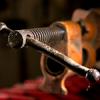Several folks around my parts have posted lumber for sale on local online classifieds. Typically, they had the trees cut and sawed on their property and then stacked the boards in a barn. Now, 20 or so years later, they've realized they won't use it and want to sell it.
My question to you all is, how do I dodge crappy lumber, and is it worth it to buy from folks like this?
I assume I'll need to check the boards for bugs, wormholes, etc. And obviously if lumber is all twisted and poorly stacked it's probably best to avoid. But are there any other things to watch for?
Isn't air-dried lumber supposed to be a treat for hand tool woodworkers?
My only experience buying local lumber has been from a guy who converted a trailer into a kiln, and honestly the lumber never seemed to be fully dry (I don't have a moisture meter), plus it didn't work like other kiln-dried lumber. I can't really explain it other than it was a booger to work all the time. It was a mix of red oak and white oak.
Anyway, there are some good "deals" out there, but I don't want to waste my money. Can anyone advise?




 Reply With Quote
Reply With Quote





